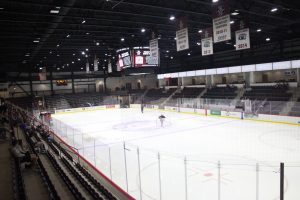President Harris Looks Forward to Next 5 Years in State of Union Address
February 2, 2023
President David Harris spoke to the Union community for his State of Union address, acknowledging past successes of his tenure and championing a vision of Union College over the next five years. Harris spoke of the considerable positive feedback to his Union College Challenge, announcing the system of prizes for participants. But Harris’ speech was more concerned with the topic of Union’s future, the development of its academic programs, athletic opportunities, facilities, staff, and communications with students. The President also discussed several challenges he believes will face the college over the next five years.
The address was an opportunity for students to learn a great deal about the economics of the College, details about the income, expenditures, and details about the endowment that are typically opaque. The President spoke of the endowment’s underperformance, and attributed it to market conditions and inflation. The President also spoke of reducing volatility in payments from the endowment fund being the goal, rather than reducing volatility in the accumulation of capital in the fund.
While the President spoke of many issues, three stood out as particularly impactful for Union’s future. The demographic cliff, new curricula, and the branding issue.
The Demographic Cliff:
One of the most profound parts of the address was the President’s ready acknowledgement of the so-called demographic cliff. That is, the expected quick decline in college applications over the next decade. While the focus of the college administration has been on reducing the effects of the COVID-19 pandemic for the past three years, the public focus of the President on getting through that crisis. But with the end of the acute crisis that COVID-19 posed to applications to the College and the workforce at the College, the President is now forced to contend with the demographic cliff, which is likely to be Union’s next major challenge.
It is incorrect to say that Union is unprepared for the demographic cliff. Rather, several actions by the administration over the past few years do seem to indicate attempts to reduce the effects of a potential cliff. Take for example an increase in the acceptance rate of the College despite rooms in several residence halls being overcrowded. The President did not give concrete examples of what the College already has done to attempt to avert the most drastic effects of the cliff, rather he was more focused on what the college wouldn’t do.
Harris indicated that the sticker price for Union tuition was unlikely to decrease, but that high price – Union’s tuition being higher than the median income of the United States – itself creates issues with admissions. Harris seems skeptical of the idea of lowering the price outright, but acknowledges that Union will have to contend with other colleges offering greater amounts of money through merit scholarships to attract students.
New Curricula:
In the realm of programming, Harris spoke of increasing investments in computer science using funding from the Templeton Institute. But on top of enhancing existing previous majors, there are significant aspirations to build out a more robust engineering program at Union.
Harris also looked forward to the future, specifically to two new majors, Civil and Environmental Engineering, to come to the college. Beginning in Fall 2023, civil engineering will be a major for the first time since 2005, when it was removed from the curriculum. Additionally, Environmental Engineering, previously only a minor, will soon be available as a major.
With the launch of a new residential curriculum, the college aims to sponsor a new sense of community and belonging across class years, Harris explained. As far as objectives for this new curriculum, Harris said that the purpose was for students to develop goals within year and between years. As far as the relationship between the typical academic curriculum and the new residential curriculum, it’s unclear exactly how the two will relate.
Harris also spoke of greater integration between liberal arts and STEM programs being more integrated through the actions of professors teaching increasingly diverse subjects.
As far as the facilities for the Union’s premiere sports program, Hockey, Harris spoke of the proposed new ice rink, which may eventually be by Mohawk Harbor. No specific dates were given, but the cost of refurbishment for Messa Rink seems too high to justify. Harris said that Union will be cooperating with local public and private partners.
Making Union Special:
Harris combined the topics of marketing of reaching core constituents. This is partially a rebranding initiative. Recommendations about Union’s brand were solicited starting last calendar year, and Harris spoke of the need to draw a connection between students and their college, including the campus and the sports teams.
But the initiative goes further than that, nor is it simply an issue of branding in a strict sense. Rather, it is the attempt of the College to increase the sense of belonging in the community. Independent of wealth, race, or other demographics, students ought to be about to have the space to do their best, says Harris. The mission of the College’s Diversity, Equity, Inclusion and Belonging (DEIB) efforts has expanded to admissions. Through the Schuler initiative, Union raised $20 million dollars (matched by $20 million more) to help more than a dozen Pell Grant recipients attend Union.
The purpose of this initiative, as well as others with an emphasis on inclusion, is to ensure that the student experiences should be at the same level regardless of demographics. Harris spoke highly of initiatives to increase the number of women attending Union.
Harris explained that he wants the college to be a place where anyone can achieve full potential regardless of wealth, and lauded the efforts of DEIB officers Dru Alvez and Franchesca Callahan, who have contributed to this through efforts through relationships with students and staff.
It ultimately remains to be seen how the President’s predictions and hopes will turn out.
Reporting was contributed to by News Editor Allyson Bennett.






